2017 TOYOTA HILUX gas type
[x] Cancel search: gas typePage 2 of 720

TABLE OF CONTENTS2
HILUX_OM_OM0K322E_(EE)
For your information .......................8
Reading this manual.....................14
How to search ..............................15
Pictorial index ...............................16
1-1. For safe use
Before driving.......................36
For safe driving ....................38
Seat belts .............................40
SRS airbags.........................45
Exhaust gas precautions .....56
1-2. Child safety
Front passenger occupant
classification system ..........57
Airbag manual on-off
system ...............................62
Riding with children..............64
Child restraint systems ........65
1-3. Theft deterrent system
Engine immobilizer
system ...............................95
Alarm .................................119
2. Instrument cluster
Warning lights
and indicators.................. 124
Gauges and meters........... 132
Multi-information display
(Type A) .......................... 137
Multi-information display
(Type B) .......................... 141
Fuel consumption
information ...................... 149
3-1. Key information
Keys .................................. 152
3-2. Opening, closing and
locking the doors
Side doors ......................... 174
Access panels (smart-cab
models only).................... 180
Tailgate ............................. 181
Smart entry & start
system............................. 184
3-3. Adjusting the seats
Front seats ........................ 218
Rear seats ......................... 220
Head restraints .................. 223
3-4. Adjusting the steering
wheel and mirrors
Steering wheel .................. 226
Inside rear view mirror....... 228
Outside rear view
mirrors ............................. 229
1For safety and security
2Instrument cluster
3Operation of
each component
Page 52 of 720

521-1. For safe use
HILUX_OM_OM0K322E_(EE)
■If the SRS airbags deploy (inflate)
● Slight abrasions, burns, bruising etc., may be sustained from SRS airbags,
due to the extremely high speed deployment (inflation) by hot gases.
● A loud noise and white powder will be emitted.
● Vehicles without SRS curtain shield airbags: Parts of the airbag module
(steering wheel hub, airbag cover and inflator) as well as the front seats may
be hot for several minutes. The airbag itself may also be hot.
● Vehicles with SRS curtain shield airbags: Parts of the airbag module (steer-
ing wheel hub, airbag cover and inflator) as well as the front seats, parts of
the front and rear pillars, and roof side rails, may be hot for several minutes.
The airbag itself may also be hot.
● The windshield may crack.
● Vehicles with ERA-GLONASS/EVAK: If the SRS airbags deploy, the system
is designed to send an emergency call* to the ERA-GLONASS/EVAK con-
trol center, notifying them of the vehicle’s location (without needing to push
the “SOS” button) and an agent will attempt to speak with the occupants to
ascertain the level of emergency and assistance required. If the occupants
are unable to communicate, the agent automatically treats the call as an
emergency and helps to dispatch the necessary emergency services.
( P. 528)
*: In some cases, the call cannot be made. (P. 531)
■ SRS airbag deployment conditions (SRS front airbags)
● The SRS front airbags will deploy in the event of an impact that exceeds the
set threshold level (the level of force corresponding to an approximately 20 -
30 km/h [12 - 18 mph] frontal collision with a fixed wall that does not move or
deform).
However, this threshold velocity will be considerably higher in the following
situations:
• If the vehicle strikes an object, such as a parked vehicle or sign pole,
which can move or deform on impact
• If the vehicle is involved in an underride collision, such as a collision in
which the front of the vehicle “underrides”, or goes under, the bed of a
truck
● Depending on the type of collision, it is possible that only the seat belt pre-
tensioners will activate.
● Vehicles with front passenger occupant classification system: The SRS front
airbags for the front passenger will not activate if there is no passenger sit-
ting in the front passenger seat. However, the SRS front airbags for the front
passenger may deploy if luggage is put in the seat, even if the seat is unoc-
cupied.
Page 304 of 720

3044-4. Refueling
HILUX_OM_OM0K322E_(EE)
Opening the fuel tank cap
●Close all the doors and windows, and turn the engine switch to the
“LOCK” position (vehicles without smart entry & start system) or off
(vehicles with smart entry & start system).
● Confirm the type of fuel.
■Fuel types
P. 692
■ Fuel tank opening for unleaded gasoline (gasoline engine)
To help prevent incorrect fueling, your vehicle has a fuel tank opening that
only accommodates the special nozzle on unleaded fuel pumps.
Perform the following steps to open the fuel tank cap:
Before refueling the vehicle
Page 401 of 720
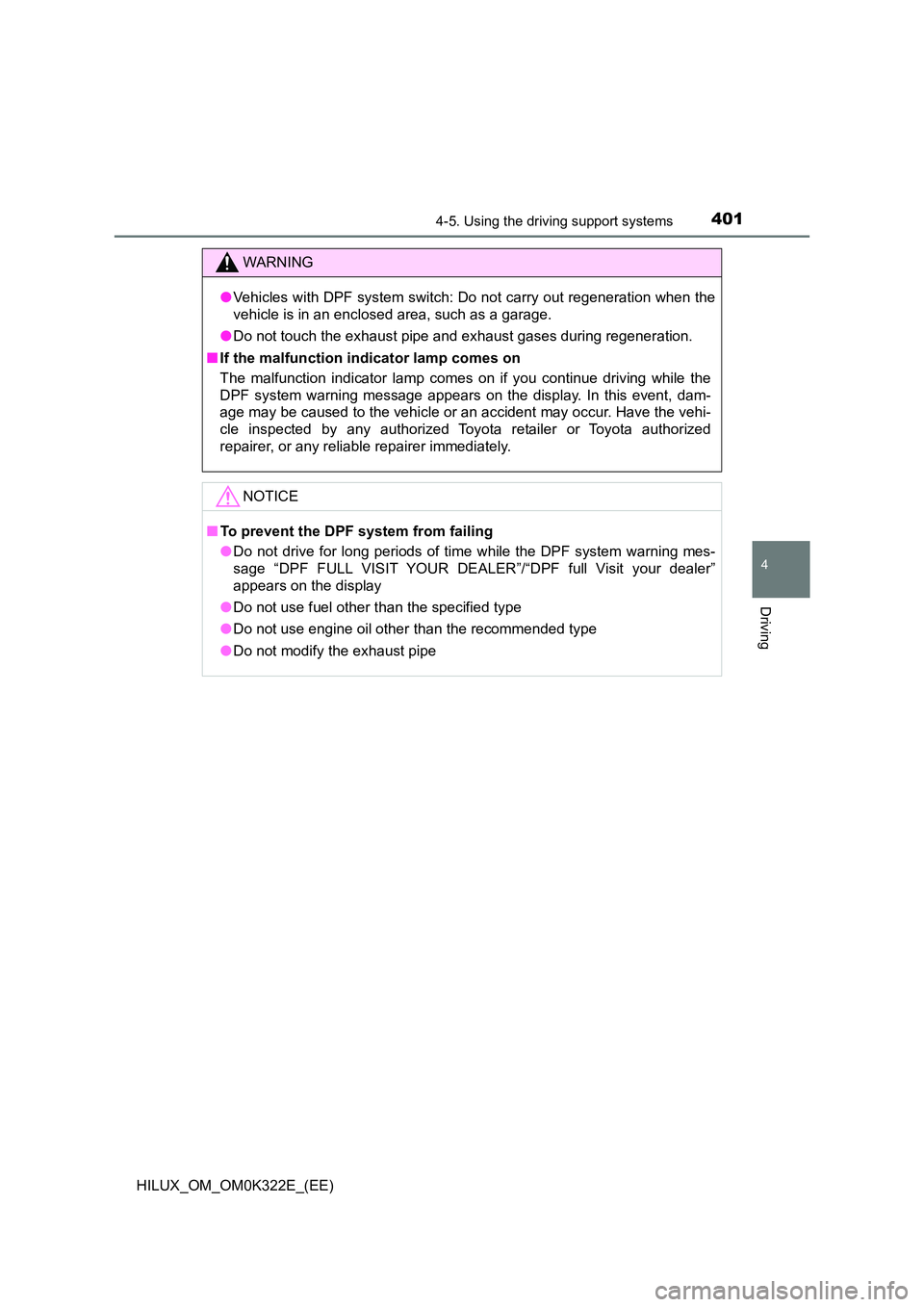
4014-5. Using the driving support systems
4
Driving
HILUX_OM_OM0K322E_(EE)
WARNING
●Vehicles with DPF system switch: Do not carry out regeneration when the
vehicle is in an enclosed area, such as a garage.
● Do not touch the exhaust pipe and exhaust gases during regeneration.
■ If the malfunction indicator lamp comes on
The malfunction indicator lamp comes on if you continue driving while the
DPF system warning message appears on the display. In this event, dam-
age may be caused to the vehicle or an accident may occur. Have the vehi-
cle inspected by any authorized Toyota retailer or Toyota authorized
repairer, or any reliable repairer immediately.
NOTICE
■ To prevent the DPF system from failing
● Do not drive for long periods of time while the DPF system warning mes-
sage “DPF FULL VISIT YOUR DEALER”/“DPF full Visit your dealer”
appears on the display
● Do not use fuel other than the specified type
● Do not use engine oil other than the recommended type
● Do not modify the exhaust pipe
Page 539 of 720
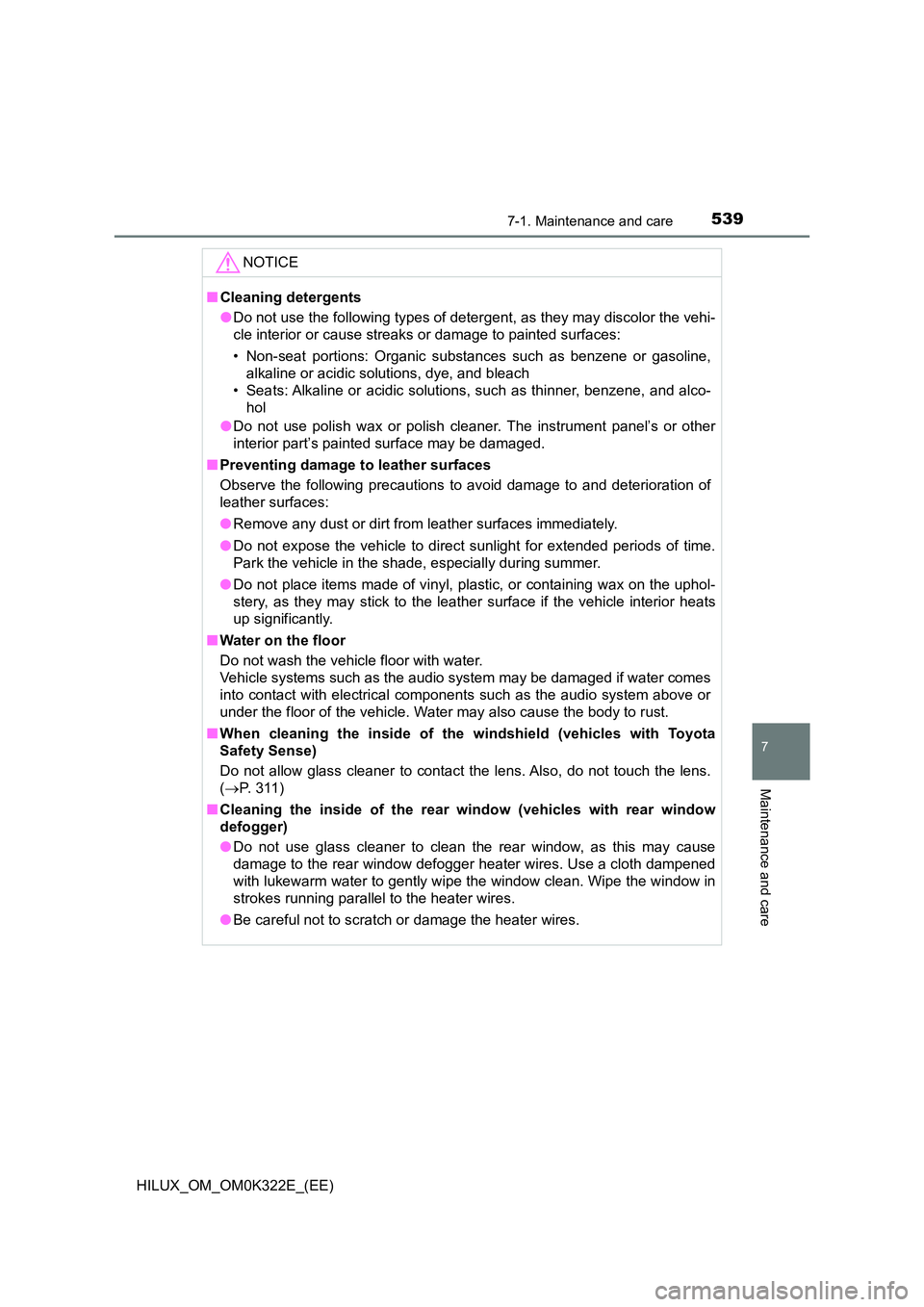
5397-1. Maintenance and care
7
Maintenance and care
HILUX_OM_OM0K322E_(EE)
NOTICE
■Cleaning detergents
● Do not use the following types of detergent, as they may discolor the vehi-
cle interior or cause streaks or damage to painted surfaces:
• Non-seat portions: Organic substances such as benzene or gasoline,
alkaline or acidic solutions, dye, and bleach
• Seats: Alkaline or acidic solutions, such as thinner, benzene, and alco-
hol
● Do not use polish wax or polish cleaner. The instrument panel’s or other
interior part’s painted surface may be damaged.
■ Preventing damage to leather surfaces
Observe the following precautions to avoid damage to and deterioration of
leather surfaces:
● Remove any dust or dirt from leather surfaces immediately.
● Do not expose the vehicle to direct sunlight for extended periods of time.
Park the vehicle in the shade, especially during summer.
● Do not place items made of vinyl, plastic, or containing wax on the uphol-
stery, as they may stick to the leather surface if the vehicle interior heats
up significantly.
■ Water on the floor
Do not wash the vehicle floor with water.
Vehicle systems such as the audio system may be damaged if water comes
into contact with electrical components such as the audio system above or
under the floor of the vehicle. Water may also cause the body to rust.
■ When cleaning the inside of the windshield (vehicles with Toyota
Safety Sense)
Do not allow glass cleaner to contact the lens. Also, do not touch the lens.
( P. 3 1 1 )
■ Cleaning the inside of the rear window (vehicles with rear window
defogger)
● Do not use glass cleaner to clean the rear window, as this may cause
damage to the rear window defogger heater wires. Use a cloth dampened
with lukewarm water to gently wipe the window clean. Wipe the window in
strokes running parallel to the heater wires.
● Be careful not to scratch or damage the heater wires.
Page 558 of 720
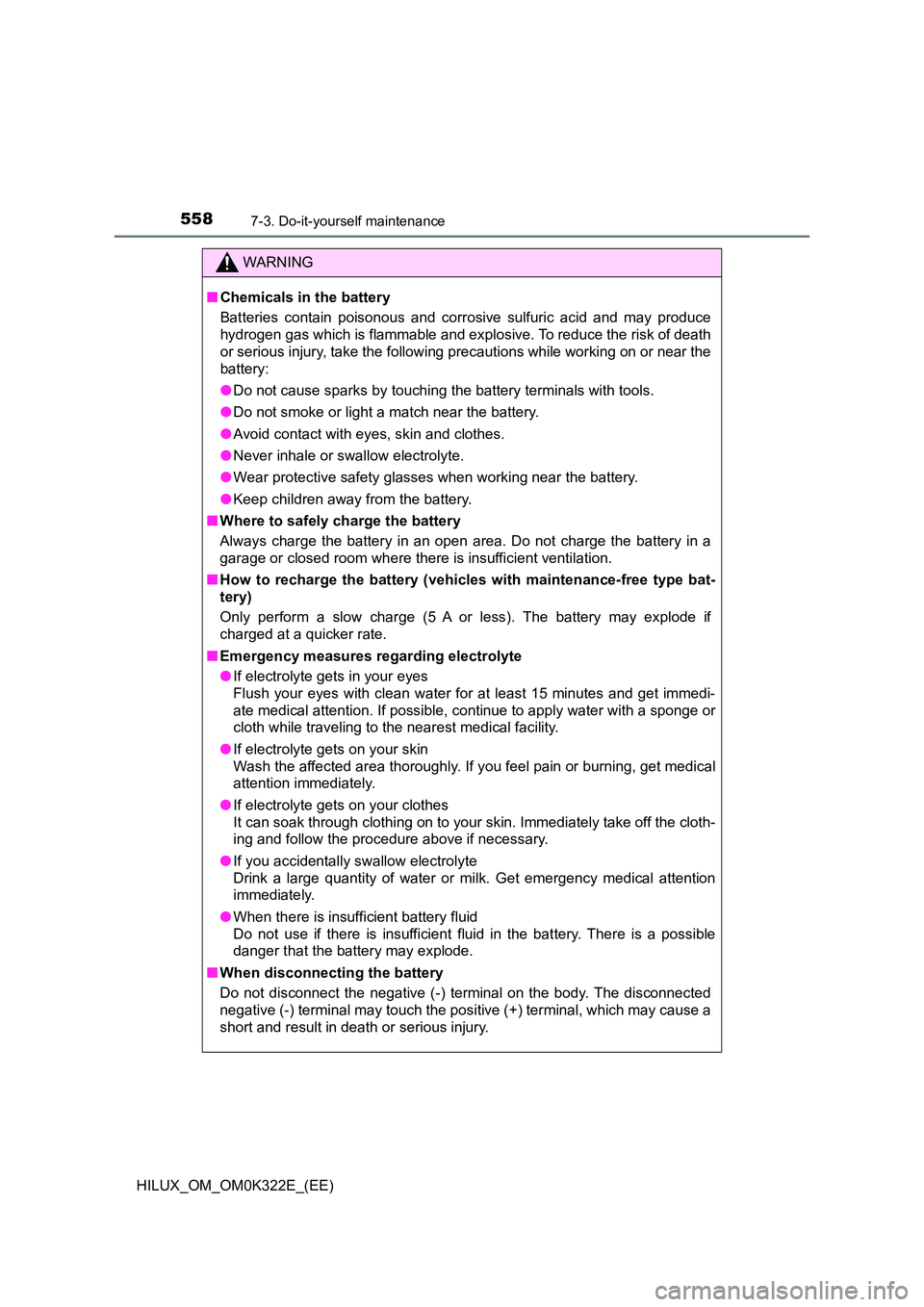
5587-3. Do-it-yourself maintenance
HILUX_OM_OM0K322E_(EE)
WARNING
■Chemicals in the battery
Batteries contain poisonous and corrosive sulfuric acid and may produce
hydrogen gas which is flammable and explosive. To reduce the risk of death
or serious injury, take the following precautions while working on or near the
battery:
● Do not cause sparks by touching the battery terminals with tools.
● Do not smoke or light a match near the battery.
● Avoid contact with eyes, skin and clothes.
● Never inhale or swallow electrolyte.
● Wear protective safety glasses when working near the battery.
● Keep children away from the battery.
■ Where to safely charge the battery
Always charge the battery in an open area. Do not charge the battery in a
garage or closed room w here there is insufficient ventilation.
■ How to recharge the battery (vehicles with maintenance-free type bat-
tery)
Only perform a slow charge (5 A or less). The battery may explode if
charged at a quicker rate.
■ Emergency measures regarding electrolyte
● If electrolyte gets in your eyes
Flush your eyes with clean water for at least 15 minutes and get immedi-
ate medical attention. If possible, continue to apply water with a sponge or
cloth while traveling to the nearest medical facility.
● If electrolyte gets on your skin
Wash the affected area thoroughly. If you feel pain or burning, get medical
attention immediately.
● If electrolyte gets on your clothes
It can soak through clothing on to your skin. Immediately take off the cloth-
ing and follow the procedure above if necessary.
● If you accidentally swallow electrolyte
Drink a large quantity of water or milk. Get emergency medical attention
immediately.
● When there is insufficient battery fluid
Do not use if there is insufficient fluid in the battery. There is a possible
danger that the battery may explode.
■ When disconnecting the battery
Do not disconnect the negative (-) terminal on the body. The disconnected
negative (-) terminal may touch the positive (+) terminal, which may cause a
short and result in death or serious injury.
Page 670 of 720
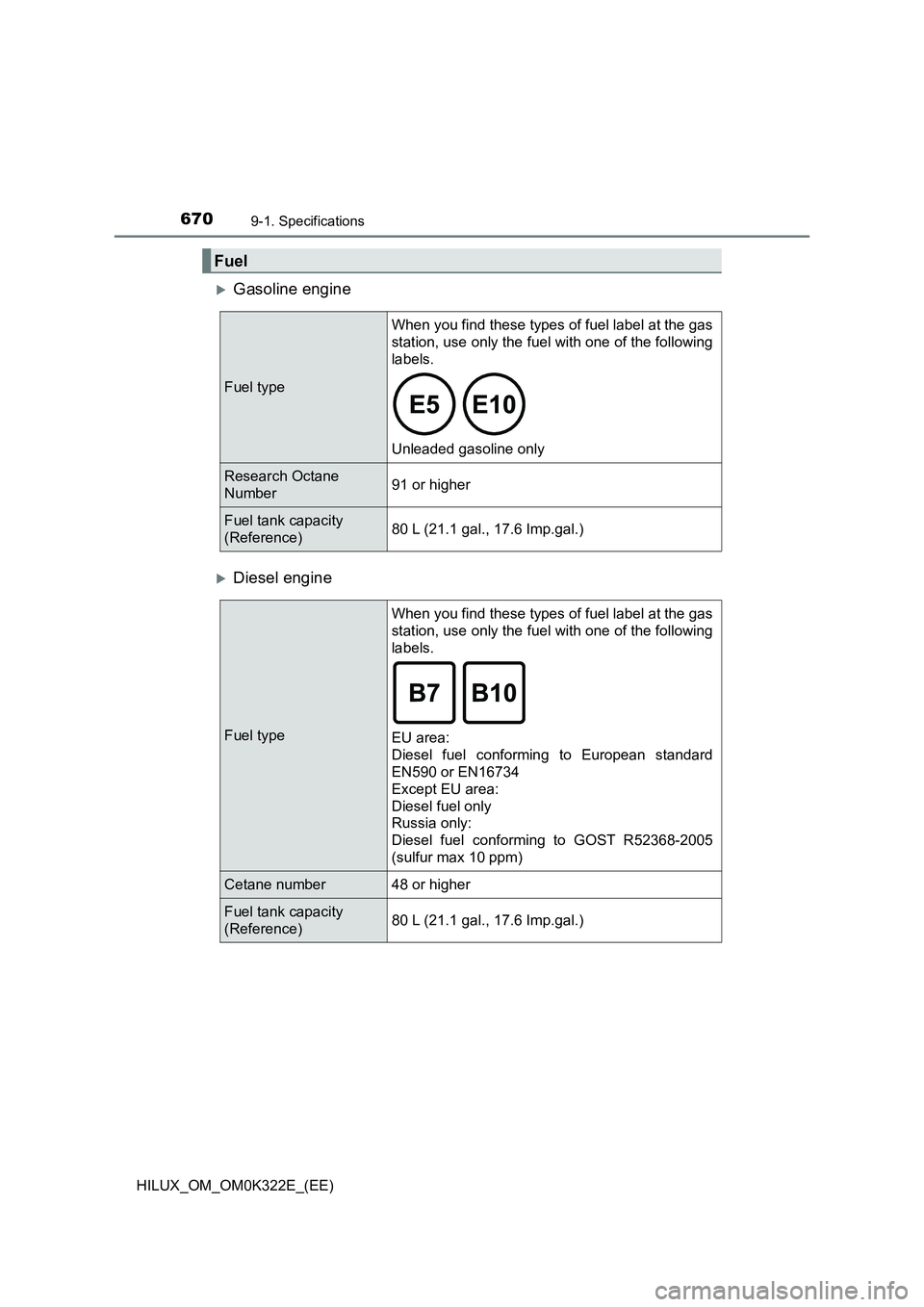
6709-1. Specifications
HILUX_OM_OM0K322E_(EE)
Gasoline engine
Diesel engine
Fuel
Fuel type
When you find these types of fuel label at the gas
station, use only the fuel with one of the following
labels.
Unleaded gasoline only
Research Octane
Number 91 or higher
Fuel tank capacity
(Reference)80 L (21.1 gal., 17.6 Imp.gal.)
Fuel type
When you find these types of fuel label at the gas
station, use only the fuel with one of the following
labels.
EU area:
Diesel fuel conforming to European standard
EN590 or EN16734
Except EU area:
Diesel fuel only
Russia only:
Diesel fuel conforming to GOST R52368-2005
(sulfur max 10 ppm)
Cetane number 48 or higher
Fuel tank capacity
(Reference)80 L (21.1 gal., 17.6 Imp.gal.)
Page 684 of 720
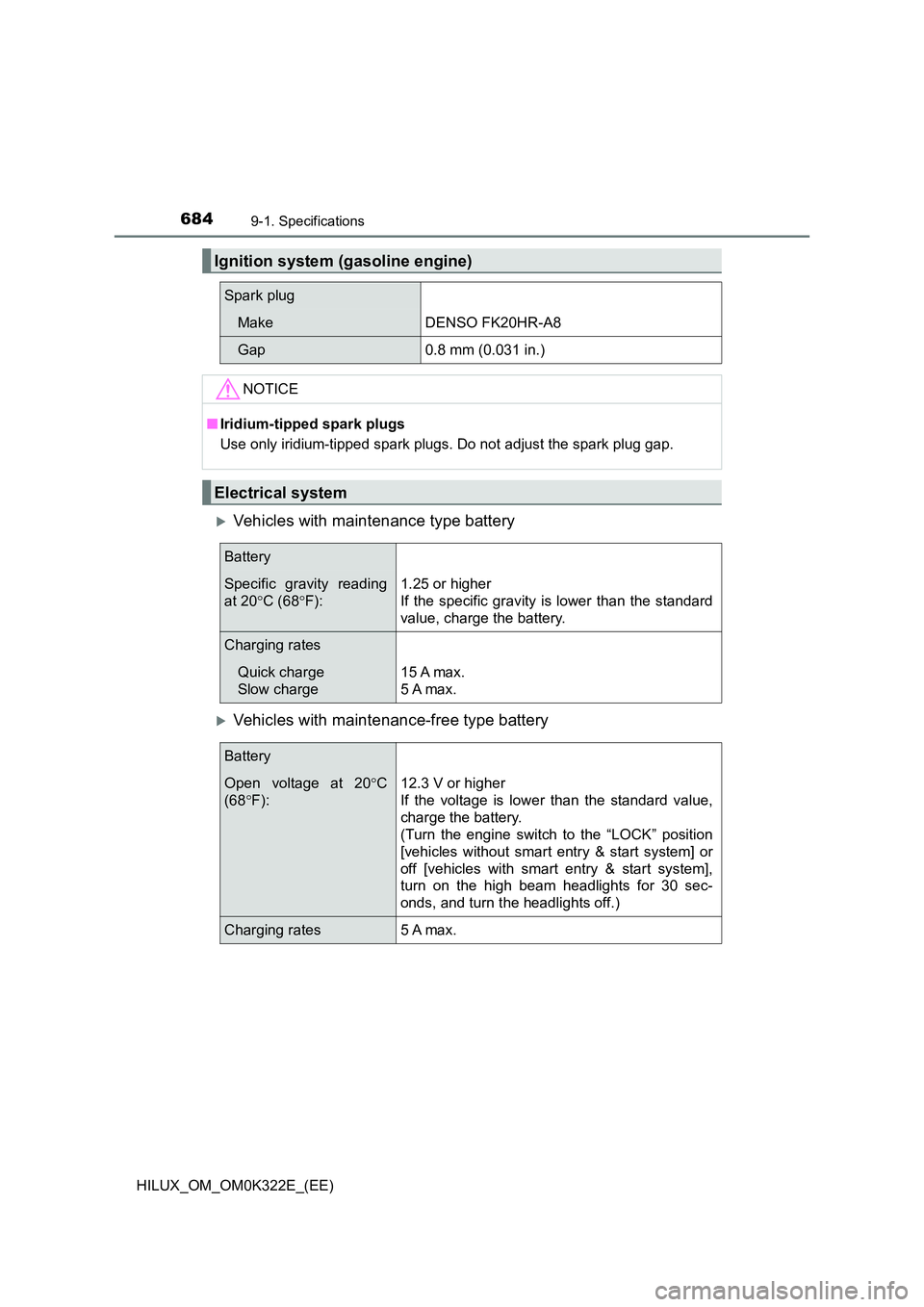
6849-1. Specifications
HILUX_OM_OM0K322E_(EE)
Vehicles with maintenance type battery
Vehicles with maintenance-free type battery
Ignition system (gasoline engine)
Spark plug
MakeDENSO FK20HR-A8
Gap0.8 mm (0.031 in.)
NOTICE
■Iridium-tipped spark plugs
Use only iridium-tipped spark plugs. Do not adjust the spark plug gap.
Electrical system
Battery
Specific gravity reading
at 20 C (68F):
1.25 or higher
If the specific gravity is lower than the standard
value, charge the battery.
Charging rates
Quick charge
Slow charge
15 A max.
5 A max.
Battery
Open voltage at 20 C
(68 F):
12.3 V or higher
If the voltage is lower than the standard value,
charge the battery.
(Turn the engine switch to the “LOCK” position
[vehicles without smart entry & start system] or
off [vehicles with smart entry & start system],
turn on the high beam headlights for 30 sec-
onds, and turn the headlights off.)
Charging rates 5 A max.